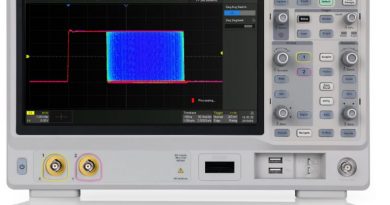Oscilloscope Sample Rates & Fidelity
Digital designers primarily use a digital storage oscilloscope to take signal integrity measurements including eye margin, rise/fall times, and setup/hold times. The most important specifications that affect the signal integrity measurement accuracy of an oscilloscope are bandwidth and sample rate. While most electrical engineers know how much bandwidth they need, they are often confused by sample rates and often assume that the highest sample rate will produce the most accurate digital measurements.
Sampling fidelity is usually more important than maximum sample rate when one is selecting an oscilloscope for fast and accurate digital measurement. It may come as a surprise that an oscilloscope with a higher sample rate can have poorer signal fidelity resulting from poorly aligned interleaved analog-to-digital converters. Fortunately, one can characterize and compare an oscilloscope’s analog-to-digital converter’s sampling fidelity by analyzing time- and frequency-domain.
So how much sample rate will one need for one’s digital measurement applications? While some engineers trust Nyquist’s Sampling Theorem — which states that for a limited bandwidth signal with a maximum frequency, the equally-spaced sampling frequency should be greater than twice the maximum frequency so that the signal will be reconstructed without aliasing — and while these engineers aim for a sample rate twice the oscilloscope’s bandwidth, others mistrust digital filtering techniques with regard to Nyquist criteria and look for a sample rate ten to twenty times the oscilloscope’s bandwidth; however, the ideal sample rate lies between these two extremes.
In order to minimize sampling significant frequency components above the maximum frequency, or Nyquist frequency, the majority of oscilloscope vendors specify the bandwidth of an oscilloscope with a typical Gaussian frequency response of between one fourth to one fifth or lower than the instrument’s real-time sample rate. While sampling at higher rates with regard to the digital storage oscilloscope’s bandwidth would mitigate the possibility of sampling significant frequency components beyond the maximum frequency, a sample rate-to-bandwidth ratio of four to one is generally adequate for producing reliable measurements.
One might assume that doubling the sample rate will lead to dramatically improved measurement and waveform results, but the improvements are rather minimal. This limited improvement in waveform fidelity is a consequence of doubling the oscilloscope’s sample-rate-to-bandwidth ratio without introducing additional error sources.
Keep in mind that Nyquist’s Sampling Theorem assumes evenly-spaced samples, which many engineers overlook when selecting a digital storage oscilloscope.
